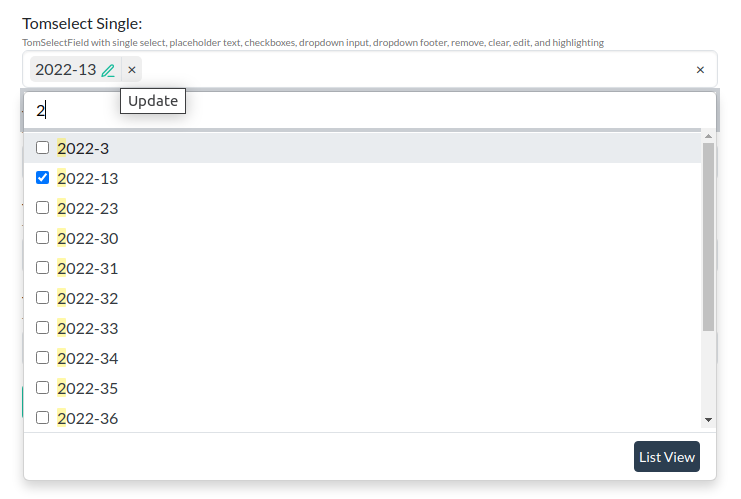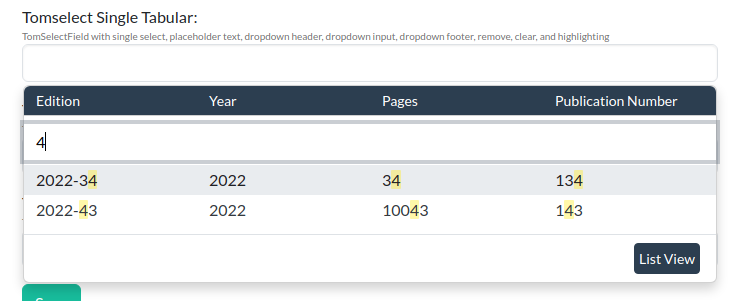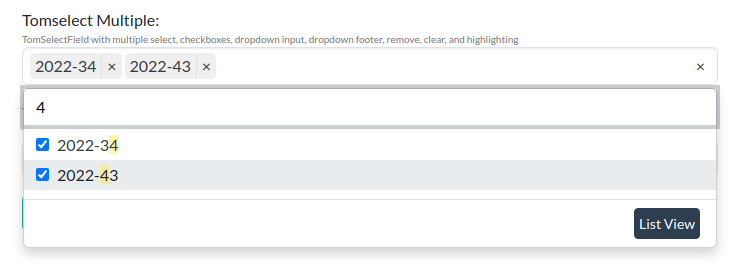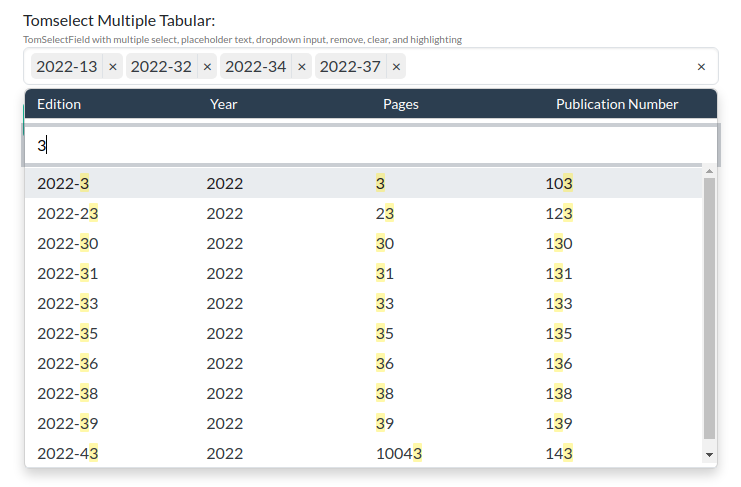Django autocomplete form fields and views using Tom Select.
This package provides a Django autocomplete field and view that can be used together to provide a user interface for selecting a model instance from a database table.
The package is adapted from the fantastic work of Philip Becker in mizdb-tomselect, with the goal of a more generalized solution for Django autocompletion and a focus on use of django templates, translations, customization, explicitness, and minimal use of custom JavaScript
- Tom Select for Django
The following examples show the Tom Select fields in action. The first two examples show the Tom Select fields with single selection, with and without the tabular display.
The next two examples show the Tom Select fields with multiple selection, with and without the tabular display.
Install:
pip install -U django-tomselectAdd to installed apps:
INSTALLED_APPS = [
# ...
"django_tomselect"
]Add an autocomplete view for each model that you want to use with django-tomselect:
# views.py
from django_tomselect.views import AutocompleteView
from .models import City, Person
class CityAutocompleteView(AutocompleteView):
model = City
class PersonAutocompleteView(AutocompleteView):
model = Person
search_lookups = [
"full_name__icontains",
]Configure endpoints for autocomplete requests:
# urls.py
from django.urls import path
from .views import CityAutocompleteView, PersonAutocompleteView
urlpatterns = [
# ...
path("autocomplete-person/", PersonAutocompleteView.as_view(), name="person_autocomplete"),
path("autocomplete-city/", CityAutocompleteView.as_view(), name="city_autocomplete"),
]To make the field display tabular results, create a PluginDropdownHeader configuration object:
from django_tomselect.configs import PluginDropdownHeader
person_plugin_dropdown_header = PluginDropdownHeader(
# The column header label for the valueField column
value_field_label="ID",
# The column header label for the labelField column
label_field_label="Full Name",
extra_columns={
"first_name": "First Name",
"last_name": "Last Name",
},
)Use the fields in a form.
from django import forms
from django_tomselect.forms import TomSelectField
from .models import City, Person
class MyForm(forms.Form):
city = TomSelectField(
url="my_autocomplete_view",
value_field="id",
label_field="name",
)
# Display results in a table, with additional columns for fields
# "first_name" and "last_name":
person = TomSelectField(
url="my_autocomplete_view",
value_field="id",
label_field="full_name",
plugin_dropdown_header=person_plugin_dropdown_header,
)NOTE: Make sure to include bootstrap 4 or 5, and the form media (or manually add the tomselect css and js files) in your template:
<!DOCTYPE html>
<html lang="en">
<head>
<meta charset="UTF-8">
<title>Django Tom Select Demo</title>
<script src="https://cdn.jsdelivr.net/npm/bootstrap@5.2.3/dist/js/bootstrap.bundle.min.js" integrity="sha384-kenU1KFdBIe4zVF0s0G1M5b4hcpxyD9F7jL+jjXkk+Q2h455rYXK/7HAuoJl+0I4" crossorigin="anonymous"></script>
<link href="https://cdn.jsdelivr.net/npm/bootstrap@5.2.3/dist/css/bootstrap.min.css" rel="stylesheet" integrity="sha384-rbsA2VBKQhggwzxH7pPCaAqO46MgnOM80zW1RWuH61DGLwZJEdK2Kadq2F9CUG65" crossorigin="anonymous">
{{ form.media }}
</head>
<body>
<div class="container">
<form>
{% csrf_token %}
{{ form.as_div }}
<button type="submit" class="btn btn-success">Save</button>
</form>
</div>
</body>
</html>The form fields pass attributes necessary to make autocomplete requests to the HTML element via the dataset property. The Tom Select element is then initialized from the attributes in the dataset property.
Base autocomplete fields for ModelChoiceField and ModelMultipleChoiceField. The arguments of TomSelectField & TomSelectMultipleField are:
| Argument | Default value | Type | Description |
|---|---|---|---|
| model | required | Model | the model class that provides the choices |
| url | "autocomplete" |
str | URL pattern name of the autocomplete view |
| value_field | f"{model._meta.pk.name}" |
str | model field that provides the value of an option |
| label_field | getattr(model, "name_field", "name") |
str | model field that provides the label of an option |
| create_field | "" | str | model field name used to create new objects with (see below) |
| listview_url | "" | str | URL name of the list view for this model (see below) |
| create_url | "" | str | URL name of the create view for this model(see below) |
| update_url | "" | str | URL name of the update view for each instance of this model(see below) |
| filter_by | () | tuple | a 2-tuple defining an additional filter (see below) |
| bootstrap_version | 5 | int (4 or 5) | the bootstrap version to use, either 4 or 5, overriding the default in django settings |
| general_config | GeneralConfig() | GeneralConfig | A GeneralConfig object or None |
| plugin_checkbox_options | PluginCheckboxOptions() | PluginCheckboxOptions | A PluginCheckboxOptions object or None |
| plugin_dropdown_input | PluginDropdownInput() | PluginDropdownInput | A PluginDropdownInput object or None |
| plugin_clear_button | PluginClearButton() | PluginClearButton | A PluginClearButton object or None |
| plugin_remove_button | PluginRemoveButton() | PluginRemoveButton | A PluginRemoveButton object or None |
| plugin_dropdown_header | PluginDropdownHeader() | PluginDropdownHeader | A PluginDropdownHeader object or None |
| plugin_dropdown_footer | PluginDropdownFooter() | PluginDropdownFooter | A PluginDropdownFooter object or None |
The TomSelect fields can be configured be passing in instances of the following classes from django_tomselect.configs:
| Class | Description |
|---|---|
django_tomselect.configs.GeneralConfig |
Base class for all configuration objects. |
django_tomselect.configs.PluginCheckboxOptions |
Configures Tom Select to display results with checkboxes. |
django_tomselect.configs.PluginDropdownInput |
Configures the Tom Select dropdown to display an input field for searching and displaying selected results. |
django_tomselect.configs.PluginClearButton |
Configures Tom Select to display a button to clear all selected values. |
django_tomselect.configs.PluginRemoveButton |
Configures Tom Select to display a button to clear a single selected value. |
django_tomselect.configs.PluginDropdownHeader |
Configures the Tom Select dropdown to display results in a table. |
django_tomselect.configs.PluginDropdownFooter |
Configures the footer to be displayed in the Tom Select dropdown. |
Available arguments:
| Argument | Default value | Type | Description |
|---|---|---|---|
| close_after_select | None | bool or None | After a selection is made, the dropdown will remain open if in a multi-selection control or will close in a single-selection control. Setting to True will force the dropdown to close after selections are made. Setting to False will keep the dropdown open after selections are made. |
| hide_placeholder | None | bool or None | If True, the placeholder will be hidden when the control has one or more items (selected options) and is not focused. This defaults to False when in a multi-selection control, and to True otherwise. |
| highlight | True | bool | Toggles match highlighting within the dropdown menu when a search term is entered |
| load_throttle | 300 | int | The number of milliseconds to wait before requesting options from the server or None. If None, throttling is disabled. Useful when loading options dynamically while the user types a search / filter expression. |
| loading_class | "loading" | str | The class name added to the wrapper element while awaiting the fulfillment of load requests. |
| max_items | 50 | int | The max number of items the user can select. A value of 1 makes the control mono-selection, None allows an unlimited number of items. TomSelectField is limited to a value of 1, regardless of the provided config value. |
| max_options | 50 | int or None | The max number of options to display in the dropdown. Set to None for an unlimited number of options. |
| open_on_focus | True | bool | Show the dropdown immediately when the control receives focus. |
| placeholder | "Select a value" | str or None | The placeholder of the field. Defaults to input widget's placeholder, unless this one is specified. |
| preload | "focus" | bool or "focus" | If True, the load function will be called upon control initialization (with an empty search). Alternatively it can be set to "focus" to call the load function when control receives focus. |
| create | False | bool | Determines if the user is allowed to create new items that aren't in the initial list of options. |
| create_filter | None | str or None | Specifies a RegExp or a string containing a regular expression that the current search filter must match to be allowed to be created. May also be a predicate function provided as a string that takes the filter text and returns whether it is allowed. |
| create_with_htmx | False | bool | Reserved for future use. |
| minimum_query_length | 2 | int | the minimum number of characters to enter before displaying results |
Available arguments: None
Available arguments: None
Overridable template: django_tomselect/render/clear_button.html
Available arguments:
| Argument | Default value | Description |
|---|---|---|
| title | "Clear Selections" | A string to use as the title of the clear button. |
| class_name | "clear-button" | A string to use as the class name of the clear button. |
Available arguments:
| Argument | Default value | Description |
|---|---|---|
| title | "Remove this item" | A string to use as the title of the remove button. |
| label | "×" | A string to use as the label of the remove button. |
| class_name | "remove" | A string to use as the class name of the clear button. |
Overridable template: django_tomselect/render/dropdown_header.html
Adding this configuration object displays the results in tabular form. A table header will be added to the dropdown. By default, the table contains two columns: one column for the choice value (commonly the "ID" of the option) and one column for the choice label (the human-readable part of the choice).
Available arguments:
| Argument | Default value | Description |
|---|---|---|
| extra_columns | {} | a dict mapping for additional columns to be displayed, where the key is the model field name and the value is the column label |
| header_class | "container-fluid bg-primary text-bg-primary pt-1 pb-1 mb-2 dropdown-header" | the classes to use for the header container |
| title_row_class | "row" | the classes to use for the title row |
| label_class | "form-label" | the classes to use for the label column |
| value_field_label | f"{value_field.title()}" |
table header for the value column |
| label_field_label | f"{model._meta.verbose_name}" |
table header for the label column |
| show_value_field | False |
show the value field column (typically id) |
To add more columns, pass a dictionary mapping field names to column labels as
extra_columns to the PluginDropdownHeader's arguments.
from django import forms
from django_tomselect.configs import PluginDropdownHeader
from django_tomselect.forms import TomSelectField
from .models import Person
person_plugin_dropdown_header = PluginDropdownHeader(
extra_columns={
# field_name: column_label
"first_name": "First Name",
"last_name": "Last Name",
},
)
class MyForm(forms.Form):
person = TomSelectField(
url="my_autocomplete_view",
value_field="id",
label_field="full_name",
plugin_dropdown_header=person_plugin_dropdown_header,
)Important: that means that the result visible to Tom Select must have an
attribute or property with that name or the field's contents will remain empty.
The results for Tom Select are created by the view calling values() on the
result queryset, so you must make sure that the attribute name is available
on the view's root queryset as either a model field or as an annotation.
Overridable template: django_tomselect/render/dropdown_footer.html
Adding this configuration object includes a footer below the results dropdown. By default, the footer
contains a link to the list view of the model, if the listview_url argument is provided to the field.
Available arguments:
| Argument | Default value | Description |
|---|---|---|
| extra_columns | {} | a dict mapping for additional columns to be displayed, where the key is the model field name and the value is the column label |
| header_class | "container-fluid bg-primary text-bg-primary pt-1 pb-1 mb-2 dropdown-header" | the classes to use for the header container |
| title_row_class | "row" | the classes to use for the title row |
| label_class | "form-label" | the classes to use for the label column |
| value_field_label | f"{value_field.title()}" |
table header for the value column |
| label_field_label | f"{model._meta.verbose_name}" |
table header for the label column |
| show_value_field | False |
show the value field column (typically id) |
| Setting | Default value | Type | Description |
|---|---|---|---|
| TOMSELECT_BOOTSTRAP_VERSION | 5 |
int (4 or 5) | The bootstrap version to use. Either 4 or 5. Defaults to 5. This sets the project-wide default for the bootstrap_version argument of the fields. You can overwrite the default for a specific field by passing the |
| TOMSELECT_PROXY_REQUEST | "django_tomselect.utils.DefaultProxyRequest" |
DefaultProxyRequest or subclass |
Either a direct reference to a DefaultProxyRequest subclass or the path to the DefaultProxyRequest subclass to use. See below. |
| DJANGO_TOMSELECT_MINIFIED | django_tomselect.app_settings.currently_in_production_mode() |
Boolean or callable | Either a boolean or a callable that returns a boolean to determine whether to use minified static files. |
| DJANGO_TOMSELECT_GENERAL_CONFIG | GeneralConfig() | Either a GeneralConfig object or None | Sets the default for this configuration in all forms (can be overridden per-form). If not provided in settings, forms default to use the version provided in django_tomselect.configs. |
| DJANGO_TOMSELECT_PLUGIN_CLEAR_BUTTON | PluginClearButton() | Either a PluginClearButton object or None | Sets the default for this configuration in all forms (can be overridden per-form). If not provided in settings, forms default to use the version provided in django_tomselect.configs. |
| DJANGO_TOMSELECT_PLUGIN_REMOVE_BUTTON | PluginRemoveButton() | Either a PluginRemoveButton object or None | Sets the default for this configuration in all forms (can be overridden per-form). If not provided in settings, forms default to use the version provided in django_tomselect.configs. |
| DJANGO_TOMSELECT_PLUGIN_DROPDOWN_INPUT | PluginDropdownInput() | Either a PluginDropdownInput object or None | Sets the default for this configuration in all forms (can be overridden per-form). If not provided in settings, forms default to use the version provided in django_tomselect.configs. |
| DJANGO_TOMSELECT_PLUGIN_DROPDOWN_HEADER | PluginDropdownHeader() | Either a PluginDropdownHeader object or None | Sets the default for this configuration in all forms (can be overridden per-form). If not provided in settings, forms default to use the version provided in django_tomselect.configs. |
| DJANGO_TOMSELECT_PLUGIN_DROPDOWN_FOOTER | PluginDropdownFooter() | Either a PluginDropdownFooter object or None | Sets the default for this configuration in all forms (can be overridden per-form). If not provided in settings, forms default to use the version provided in django_tomselect.configs. |
| DJANGO_TOMSELECT_PLUGIN_CHECKBOX_OPTIONS | PluginCheckboxOptions() | Either a PluginCheckboxOptions object or None | Sets the default for this configuration in all forms (can be overridden per-form). If not provided in settings, forms default to use the version provided in django_tomselect.configs. |
Note: The DefaultProxyRequest class is used to obtain the model details for the autocomplete.
In order to simplify the process of creating a custom autocomplete view, django-tomselect provides
a DefaultProxyRequest class that can be used to obtain the model details from the queryset and the
request. In most cases, you will not need to use this class directly.
If you want to modify all autocomplete queries for a subclassed AutocompleteView,
you can use super() with the get_queryset() method.
from django_tomselect.views import AutocompleteView
class MyAutocompleteView(AutocompleteView):
model = MyModel
search_lookups = [
"name__icontains",
]
def get_queryset(self):
"""Toy example of filtering all queries in this view to id values less than 10"""
queryset = super().get_queryset()
queryset.filter(id__lt=10)
return querysetThe AutocompleteView filters the result QuerySet against search_lookups.
The default value for the lookup is []. Overwrite the AutocompleteView.search
method to modify the search process.
from django_tomselect.views import AutocompleteView
class MyAutocompleteView(AutocompleteView):
model = MyModel
search_lookups = [
"name__icontains",
]
def search(self, queryset, q):
# Filter using your own queryset method:
return queryset.search(q)Important: This is a work in progress. The API may change in the future.
To enable option creation in the dropdown, pass the URL name of the create view of the given model to the field. This will add an 'Add' option to the bottom of the dropdown.
The dropdown will include a link to the list view of the given model if you pass in the URL pattern name of the list view.
# urls.py
from django.urls import path
from django_tomselect.views import AutocompleteView
from django_tomselect.forms import TomSelectField
from .models import City
from .views import CityListView
urlpatterns = [
# ...
path("autocomplete/", AutocompleteView.as_view(), name="my_autocomplete_view"),
path("city/list/", CityListView.as_view(), name="city_listview"),
]
# forms.py
city = TomSelectField(
url="my_autocomplete_view",
value_field="id",
label_field="name",
listview_url="city_listview",
)Important: This is a work in progress. The API may change in the future.
Use the filter_by argument to restrict the available options of one
TomSelectField to the value selected in another form field. The parameter must
be a 2-tuple: (field_this_field_is_dependent_on, django_field_lookup).
# models.py
from django import forms
from django.db import models
from django_tomselect.forms import TomSelectField
class Person(models.Model):
name = models.CharField(max_length=50)
city = models.ForeignKey("City", on_delete=models.SET_NULL, blank=True, null=True)
class City(models.Model):
name = models.CharField(max_length=50)
is_capitol = models.BooleanField(default=False)
# forms.py
class PersonsFromCapitolsForm(forms.Form):
capitol = forms.ModelChoiceField(queryset=City.objects.filter(is_capitol=True))
person = TomSelectField(
url="my_autocomplete_view",
value_field="id",
label_field="name",
filter_by=("capitol", "city_id"),
)In this example, the options for the Person QuerySet are dependent on the
city_id for the currently selected capitol formfield value.
NOTE: When using filter_by, the declaring element now requires that the
other field provides a value, since its choices are dependent on the other
field. If the other field does not have a value, the search will not return any
results.
If a form is added dynamically after the page loads (e.g.: with htmx), the new form
fields will not be initialized as django-tomselect fields. In order to manually
initialize them, dispatch a triggerTomSelect event, providing the id of the
form field as a value in detail as follows.
<script>
window.dispatchEvent(new CustomEvent('triggerTomSelect', {
detail: {
elemID: 'id_tomselect_tabular'
}
}));
</script>If you want to use annotations in your QuerySet, you must overide your form's clean_fieldname method to remove the annotation before saving the form.
Assuming you have a model with a foreign key to a City model, and you want to annotate the City name onto the QuerySet in the AutoComplete view, you would do the following:
from django import forms
from django_tomselect.views import AutocompleteView
class MyAutocompleteView(AutocompleteView):
model = MyModel
search_lookups = [
"name__icontains",
]
def get_queryset(self):
"""Toy example of annotating the city name onto the queryset"""
queryset = super().get_queryset()
queryset = queryset.annotate(city_name=F("city__name"))
return querysetThen, in your ModelForm, you would override the clean_fieldname method to remove the annotation. Here is an example using TomSelectField for a single selection field, which should return a single model instance (or None):
from django import forms
from django_tomselect.forms import TomSelectField
from .models import City, Person
class MyForm(forms.ModelForm):
city = TomSelectField(
url="my_autocomplete_view",
value_field="id",
label_field="name",
)
def clean_city(self):
city = self.cleaned_data.get("city")
try:
city = City.objects.get(pk=data.get("pkid"))
return city
except City.DoesNotExist:
logger.error(f"Error cleaning city: {e}")
return NoneAnd an example using TomSelectMultipleField for a multi-selection field, which should return a QuerySet:
from django import forms
from django_tomselect.forms import TomSelectMultipleField
from .models import City, Person
class MyForm(forms.ModelForm):
cities = TomSelectMultipleField(
url="my_autocomplete_view",
value_field="id",
label_field="name",
)
def clean_cities(self):
cities = self.cleaned_data.get("cities")
try:
city_id_list = list(cities.values_list("city_id", flat=True))
cities_qs = City.objects.filter(id__in=city_id_list)
return cities_qs
except AttributeError as e:
logger.error(f"Error cleaning cities: {e}")
return City.objects.none()All templates are located in django_tomselect/templates/django_tomselect/.
The base template for the widgets is select.html. It contains the HTML structure for the custom widget and form field.
Additionally, each of the Render Templates has its own template.
The templates are rendered with the following context:
| Variable | Description |
|---|---|
ToDo |
ToDo |
You can override templates by creating a template with the same name in your project's templates/django_tomselect/ directory.
There are a handful of strings in the default templates that are marked for translation.
Before a new language can be added, the LANGUAGES setting must be updated with the new language code.
LANGUAGES = (
('en', _('English')),
('es', _('Spanish')),
('de', _('Deutsch')),
)To update translations, from the django_tomselect directory run python ../../manage.py maketmessages -a.
This will update the .po files in django_tomselect/locale/ directory. Once translations files have been
updated, compile them with python ../../manage.py compilemessages.
python3 -m venv venv
source venv/bin/activate
make initThen see the demo for a preview: python demo/manage.py runserver
Run tests with make test or make tox. To install required browsers for playwright: playwright install.
See the makefile for other commands.



